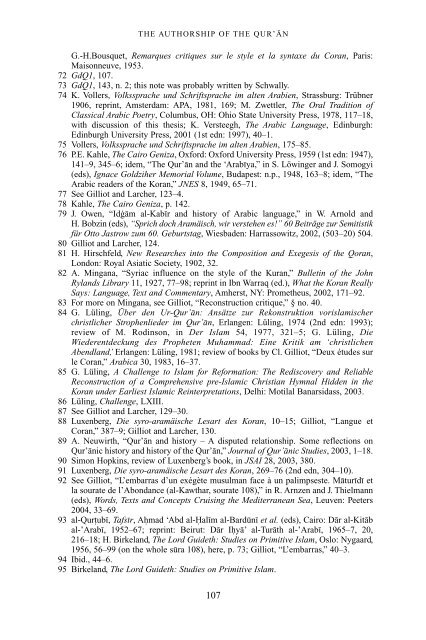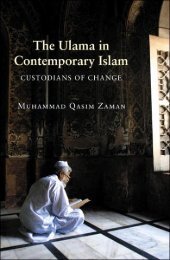The Qur'an in its historical context (pdf - Islam and Christian-Muslim ...
The Qur'an in its historical context (pdf - Islam and Christian-Muslim ...
The Qur'an in its historical context (pdf - Islam and Christian-Muslim ...
Create successful ePaper yourself
Turn your PDF publications into a flip-book with our unique Google optimized e-Paper software.
THE AUTHORSHIP OF THE QUR’AN<br />
G.-H.Bousquet, Remarques critiques sur le style et la syntaxe du Coran, Paris:<br />
Maisonneuve, 1953.<br />
72 GdQ1, 107.<br />
73 GdQ1, 143, n. 2; this note was probably written by Schwally.<br />
74 K. Vollers, Volkssprache und Schriftsprache im alten Arabien, Strassburg: Trübner<br />
1906, repr<strong>in</strong>t, Amsterdam: APA, 1981, 169; M. Zwettler, <strong>The</strong> Oral Tradition of<br />
Classical Arabic Poetry, Columbus, OH: Ohio State University Press, 1978, 117–18,<br />
with discussion of this thesis; K. Versteegh, <strong>The</strong> Arabic Language, Ed<strong>in</strong>burgh:<br />
Ed<strong>in</strong>burgh University Press, 2001 (1st edn: 1997), 40–1.<br />
75 Vollers, Volkssprache und Schriftsprache im alten Arabien, 175–85.<br />
76 P.E. Kahle, <strong>The</strong> Cairo Geniza, Oxford: Oxford University Press, 1959 (1st edn: 1947),<br />
141–9, 345–6; idem, “<strong>The</strong> Qur’an <strong>and</strong> the ‘Arabiya,” <strong>in</strong> S. Löw<strong>in</strong>ger <strong>and</strong> J. Somogyi<br />
(eds), Ignace Goldziher Memorial Volume, Budapest: n.p., 1948, 163–8; idem, “<strong>The</strong><br />
Arabic readers of the Koran,” JNES 8, 1949, 65–71.<br />
77 See Gilliot <strong>and</strong> Larcher, 123–4.<br />
78 Kahle, <strong>The</strong> Cairo Geniza, p. 142.<br />
79 J. Owen, “Id∫am al-Kabir <strong>and</strong> history of Arabic language,” <strong>in</strong> W. Arnold <strong>and</strong><br />
H. Bobz<strong>in</strong> (eds), “Sprich doch Aramäisch, wir verstehen es!” 60 Beiträge zur Semitistik<br />
für Otto Jastrow zum 60. Geburtstag, Wiesbaden: Harrassowitz, 2002, (503–20) 504.<br />
80 Gilliot <strong>and</strong> Larcher, 124.<br />
81 H. Hirschfeld, New Researches <strong>in</strong>to the Composition <strong>and</strong> Exegesis of the Qoran,<br />
London: Royal Asiatic Society, 1902, 32.<br />
82 A. M<strong>in</strong>gana, “Syriac <strong>in</strong>fluence on the style of the Kuran,” Bullet<strong>in</strong> of the John<br />
Ryl<strong>and</strong>s Library 11, 1927, 77–98; repr<strong>in</strong>t <strong>in</strong> Ibn Warraq (ed.), What the Koran Really<br />
Says: Language, Text <strong>and</strong> Commentary, Amherst, NY: Prometheus, 2002, 171–92.<br />
83 For more on M<strong>in</strong>gana, see Gilliot, “Reconstruction critique,” § no. 40.<br />
84 G. Lül<strong>in</strong>g, Über den Ur-Qur’an: Ansätze zur Rekonstruktion vorislamischer<br />
christlicher Strophenlieder im Qur’an, Erlangen: Lül<strong>in</strong>g, 1974 (2nd edn: 1993);<br />
review of M. Rod<strong>in</strong>son, <strong>in</strong> Der <strong>Islam</strong> 54, 1977, 321–5; G. Lül<strong>in</strong>g, Die<br />
Wiederentdeckung des Propheten Muhammad: E<strong>in</strong>e Kritik am ‘christlichen<br />
Abendl<strong>and</strong>,’ Erlangen: Lül<strong>in</strong>g, 1981; review of books by Cl. Gilliot, “Deux études sur<br />
le Coran,” Arabica 30, 1983, 16–37.<br />
85 G. Lül<strong>in</strong>g, A Challenge to <strong>Islam</strong> for Reformation: <strong>The</strong> Rediscovery <strong>and</strong> Reliable<br />
Reconstruction of a Comprehensive pre-<strong>Islam</strong>ic <strong>Christian</strong> Hymnal Hidden <strong>in</strong> the<br />
Koran under Earliest <strong>Islam</strong>ic Re<strong>in</strong>terpretations, Delhi: Motilal Banarsidass, 2003.<br />
86 Lül<strong>in</strong>g, Challenge, LXIII.<br />
87 See Gilliot <strong>and</strong> Larcher, 129–30.<br />
88 Luxenberg, Die syro-aramäische Lesart des Koran, 10–15; Gilliot, “Langue et<br />
Coran,” 387–9; Gilliot <strong>and</strong> Larcher, 130.<br />
89 A. Neuwirth, “Qur’an <strong>and</strong> history – A disputed relationship. Some reflections on<br />
Qur’anic history <strong>and</strong> history of the Qur’an,” Journal of Qur’anic Studies, 2003, 1–18.<br />
90 Simon Hopk<strong>in</strong>s, review of Luxenberg’s book, <strong>in</strong> JSAI 28, 2003, 380.<br />
91 Luxenberg, Die syro-aramäische Lesart des Koran, 269–76 (2nd edn, 304–10).<br />
92 See Gilliot, “L’embarras d’un exégète musulman face à un palimpseste. Maturidi et<br />
la sourate de l’Abondance (al-Kawthar, sourate 108),” <strong>in</strong> R. Arnzen <strong>and</strong> J. Thielmann<br />
(eds), Words, Texts <strong>and</strong> Concepts Cruis<strong>in</strong>g the Mediterranean Sea, Leuven: Peeters<br />
2004, 33–69.<br />
93 al-Qurtubi, Tafsir, Ahmad ‘Abd al-Halim al-Barduni et al. (eds), Cairo: Dar al-Kitab<br />
al-’Arabi, 1952–67; repr<strong>in</strong>t: Beirut: Dar Ihya’ al-Turath al-’Arabi, 1965–7, 20,<br />
216–18; H. Birkel<strong>and</strong>, <strong>The</strong> Lord Guideth: Studies on Primitive <strong>Islam</strong>, Oslo: Nygaard,<br />
1956, 56–99 (on the whole sura 108), here, p. 73; Gilliot, “L’embarras,” 40–3.<br />
94 Ibid., 44–6.<br />
95 Birkel<strong>and</strong>, <strong>The</strong> Lord Guideth: Studies on Primitive <strong>Islam</strong>.<br />
107



